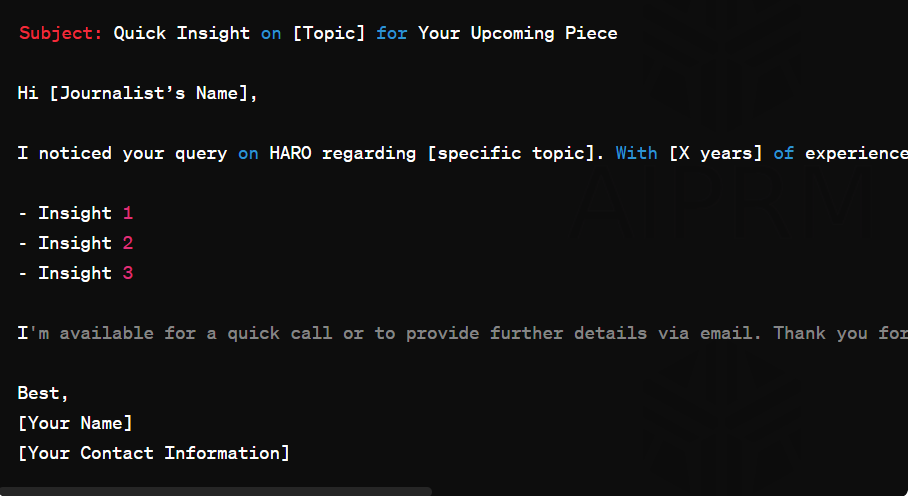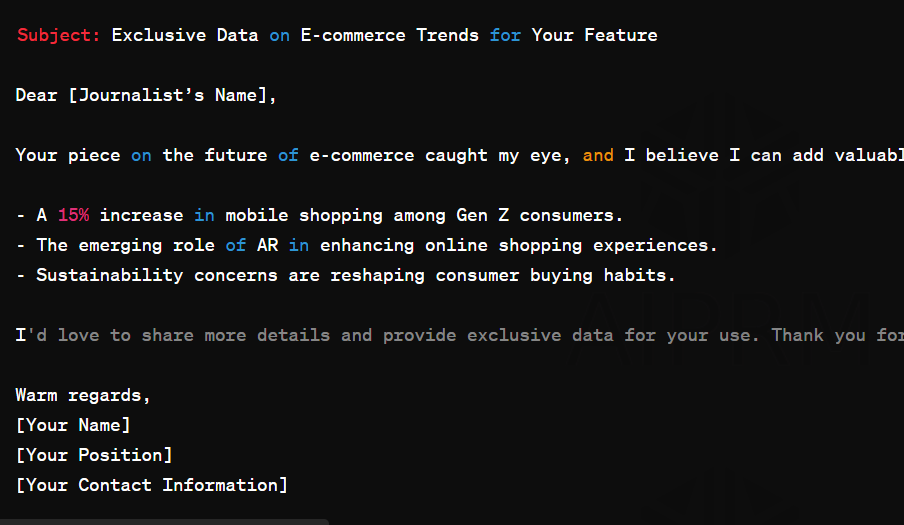25 Tips To Write a Successful HARO Pitch [Templates + Examples] | 2024
In the evolving landscape of digital marketing and content creation, one gem that continues to shine with opportunities is HARO – Help A Reporter Out. This platform connects journalists and content creators with sources to provide rich, authoritative content. However, with hundreds of pitches landing in journalists’ inboxes daily, standing out becomes a formidable challenge. In 2024, mastering the art of crafting a successful HARO pitch is more crucial than ever. Here are 25 essential tips, complete with templates and examples, to ensure your pitch cuts through the noise and captures the attention it deserves.
1. Understand the Query Completely
Before you even think about writing your pitch, ensure you fully understand what the journalist is asking for. Misinterpretations can lead to rejection.
2. Be Concise
Journalists are pressed for time. Craft your pitch to be clear and to the point, without sacrificing the quality of your response.
3. Tailor Your Bio
Customize your bio to highlight your expertise relevant to the query. This establishes credibility and shows why you’re the best source for the information.
4. Use a Catchy Subject Line
Your subject line should grab attention and make it clear that you have what the journalist needs. Think of it as the headline of your pitch.
5. Start with a Bang
Begin your pitch with an engaging introduction that hooks the reader. Whether it’s an intriguing fact, a bold statement, or a compelling anecdote, make it count.
6. Offer Unique Insights
Journalists are looking for fresh perspectives. Offer unique insights or data that can make their story stand out.
7. Be Timely
Speed is of the essence. Responding quickly can increase your chances of being selected, as many stories are time-sensitive.
8. Provide Clear Value
Make it obvious how your input adds value to their piece. Be explicit about the uniqueness of your perspective or data.
9. Follow Instructions
If the query specifies a particular format or information, follow these instructions meticulously. Deviating from these requests can lead to immediate rejection.
10. Use Bullet Points
Make your pitch easy to skim by using bullet points to organize your thoughts and information clearly.
11. Showcase Previous Work
If applicable, include links to your previous work to demonstrate your expertise and writing style.
12. Personalize Your Pitch
Avoid generic responses. Personalize your pitch to show you’ve done your homework about the journalist or publication.
13. Edit Ruthlessly
Ensure your pitch is free of grammatical errors and typos. A clean, well-edited pitch reflects professionalism.
14. Include Contact Information
Make it easy for the journalist to reach out by including your contact information at the end of your pitch.
15. Use Templates Wisely
While templates can save time, ensure you customize them to fit each query. Avoid a one-size-fits-all approach.
16. Highlight Exclusivity
In a sea of pitches that journalists sift through daily, offering something exclusive can significantly elevate your pitch’s appeal. Exclusivity means providing information, insights, or data that cannot be found elsewhere or offering a unique perspective on a topic that has been widely covered. Here’s how to effectively highlight exclusivity in your HARO pitches:
-
Offer Unique Data or Insights:
If you have proprietary research, survey results, or data analytics that haven’t been published elsewhere, make this the centerpiece of your pitch. Journalists are always on the lookout for fresh data that can add depth to their stories.
-
Share Personal Anecdotes or Case Studies:
Personal experiences or case studies that illustrate a larger trend or issue in your industry can also be very compelling. These stories provide a human element that can make a piece more relatable and engaging.
-
Provide Expert Analysis:
Offering an expert analysis on a trending topic can set your pitch apart. If you have a unique interpretation or can predict industry trends based on your expertise, highlight this in your pitch.
-
Indicate Timeliness and Relevance:
Emphasize how your information is not only exclusive but also timely. Connecting your exclusive insight to current events or trending topics increases its value and urgency.
-
Use Strong Language to Convey Exclusivity:
Phrases like “exclusive data,” “first-hand insight,” or “unpublished study” immediately grab attention. Be explicit about what makes your contribution one-of-a-kind.
-
Promise Confidentiality If Necessary:
In some cases, the information might be sensitive. Offering exclusive insights with the promise of confidentiality can be very appealing to journalists looking for insider information.
-
Be Ready to Provide Proof:
If you claim exclusivity, be prepared to back it up with evidence. Journalists will likely want to verify your claims before publishing.
-
Highlight Your Unique Position:
Explain why you, of all people, have access to this exclusive information. It could be due to your professional role, your network, or personal experiences.
17. Address the Journalist by Name
A personal touch can make a difference. Address the journalist by name to foster a more personal connection.
18. Keep Follow-ups Minimal
If you decide to follow up, do so sparingly. One polite follow-up is sufficient.
19. Leverage Social Proof
Mentioning your affiliations, awards, or notable achievements can boost your credibility.
20. Stay on Topic
Staying on topic is crucial when crafting your HARO pitch. Here’s why it’s important and how to ensure your pitch remains focused:
-
Relevance is Key:
Your pitch should directly address the journalist’s query. Avoid going off on tangents or introducing unrelated information. Staying relevant demonstrates your understanding of the journalist’s needs and increases the likelihood of your pitch being considered.
-
Respect the Journalist’s Time:
Journalists are often working on tight deadlines and sifting through numerous pitches. By staying on topic, you respect their time and make it easier for them to quickly assess the value of your response.
-
Provide Value-Adding Information:
Focusing on the topic allows you to provide valuable insights, data, or expertise that directly contribute to the journalist’s story. Irrelevant information dilutes the impact of your pitch and may result in it being overlooked.
-
Avoid Overwhelming the Journalist:
A concise and focused pitch is more likely to grab the journalist’s attention. Providing too much information or straying off topic can overwhelm them and decrease the chances of your pitch being considered.
-
Stick to the Query Guidelines:
If the journalist has provided specific guidelines or requirements in their query, make sure your pitch adheres to them closely. Deviating from the guidelines can signal to the journalist that you haven’t fully understood their needs.
-
Highlight Your Expertise Within the Topic:
Staying on topic allows you to showcase your expertise in the relevant subject matter. By demonstrating your knowledge and understanding of the topic, you increase your credibility as a valuable source for the journalist.
-
Craft a Clear and Focused Message:
A focused pitch is easier for the journalist to understand and process. Clearly articulate how your response addresses the specific aspects of the query, making it easy for the journalist to see the relevance of your contribution.
-
Review and Edit Your Pitch:
Before sending your pitch, review it carefully to ensure it stays on topic and effectively addresses the journalist’s query. Remove any extraneous information that doesn’t directly contribute to your response.
21. Offer Multiple Angles
If possible, offer different angles or options for the journalist to consider. This shows flexibility and increases your chances of being featured.
22. Respect the Process
Understand that not every pitch will be a win. Respect the journalist’s process and decision.
23. Use Quotes
Incorporating quotes into your HARO pitch can add depth, credibility, and immediacy to your response. Here’s how to effectively use quotes to enhance your pitch:
-
Select Relevant and Compelling Quotes:
Choose quotes that directly relate to the journalist’s query and add value to their story. Look for quotes that are insightful, impactful, or provide a unique perspective on the topic.
-
Attribution is Key:
Always attribute quotes to their original source. If the quote comes from you or someone within your organization, make that clear. If it’s from an external expert or a customer, provide their name and affiliation (if applicable).
-
Ensure Accuracy:
Quotes should be accurate and verifiable. Misattributed or fabricated quotes can damage your credibility and harm your chances of being selected.
-
Keep Quotes Concise:
Journalists are often working with limited space, so keep your quotes concise and to the point. Aim for clarity and brevity without sacrificing substance.
-
Use Quotes to Add Color and Authority:
Quotes can inject personality and authority into your pitch. They can provide a human element, offer expert opinions, or lend credibility to your claims.
-
Offer Exclusive Quotes:
If you have access to exclusive quotes or insights that haven’t been shared elsewhere, highlight this in your pitch. Exclusive quotes can make your pitch more appealing to journalists looking for fresh content.
-
Provide Context:
Help journalists understand the significance of the quote by providing context or explaining how it relates to the broader topic. This helps them see the relevance and importance of including the quote in their story.
-
Be Transparent:
If you’re quoting yourself or someone affiliated with your organization, be transparent about any potential biases. Transparency builds trust with journalists and readers alike.
-
Format Quotes Properly:
Use quotation marks to indicate direct speech and separate quotes from the rest of your pitch. Consider formatting longer quotes as block quotes for clarity and emphasis.
-
Follow Up with Additional Information:
If a journalist expresses interest in using your quote, be prepared to provide additional context or elaboration if needed. This demonstrates your responsiveness and commitment to helping them craft a compelling story.
24. Offer Immediate Availability
Indicate your availability for follow-up questions or interviews. This can be particularly appealing for journalists on tight deadlines.
25. Express Gratitude
Always thank the journalist for considering your pitch, regardless of the outcome. Politeness can leave a lasting impression.
Templates and Examples
To help you get started, here are a few templates and examples that incorporate these tips:
Template for a Quick Response:

Example of a Personalized Pitch:

Conclusion
Crafting a successful HARO pitch requires understanding, speed, and precision. By following these 25 tips, you’re not just throwing a message into the void; you’re strategically placing your expertise where it can make the most impact. Remember, each pitch is an opportunity to build relationships, showcase your knowledge, and achieve visibility in your industry. Happy pitching!
Stay on top of the latest AI trends and developments with Disrt Infotech. Contact us today to learn more about our Funnel & Branding services and how we can help your business succeed online.






